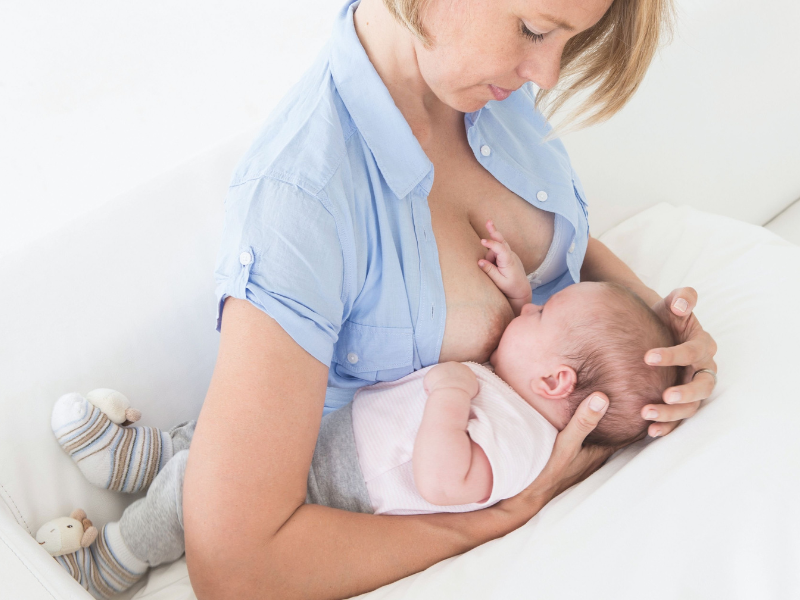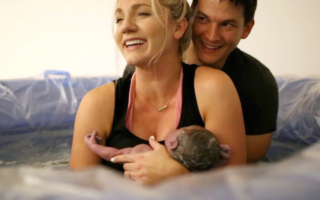Breastfeeding is an essential and nurturing process that helps in infants’ healthy growth and development. The rugby ball position has gained popularity among various breastfeeding positions for its unique benefits and comfort.
Named after how a rugby ball is held under the arm, this position has distinct features that cater to specific needs. This article explores the rugby ball breastfeeding position, covering everything from preparations to its advantages and features.
What Is the Rugby Ball Breastfeeding Position?
The rugby ball breastfeeding position is a unique and efficient method of feeding. In this position, the baby’s body is tucked under the mother’s arm on the same side they are breastfeeding from.
The baby’s legs and feet point backward, allowing a clear path to the breast. The mother supports the baby’s head at the level of her breast while the baby faces the breast, ready to latch. This position offers distinct advantages, making it a valuable choice for many breastfeeding mothers.
What Do I Need to Know Before I Use the Rugby Ball Breastfeeding Position?
Before employing the rugby ball breastfeeding position, understanding the basics is crucial for both the mother and the baby.
- Consult Healthcare Professionals: Speak with a lactation consultant or nurse to ensure this position suits your situation.
- Choose the Right Support: You may need a pillow or cushion to support your baby’s head and body.
- Comfort is Key: Ensure you and your baby are comfortable before attempting this position.
- Perfect for Specific Situations: Especially useful for mothers who have had a C-section or are breastfeeding twins.
Who Is the Rugby Ball Breastfeeding Position Suitable For?

The rugby ball position is versatile and can be suitable for a wide array of situations. Here’s who might find it particularly beneficial:
- Mothers who have had a C-Section: Since the baby’s legs point backward, they won’t press against a C-section wound, providing comfort and safety.
- Breastfeeding Twins: This position allows a mother to feed both infants simultaneously, offering an efficient method for mothers of twins.
- Mothers with Large Breasts: The rugby ball position can be adapted to suit various breast sizes, providing comfort and effective latching.
- Premature Babies or Infants with Latching Issues: Offering more control and visibility, this position can be helpful for premature babies or those with difficulty latching.
- Mothers Seeking Comfort and Visibility: With its unique alignment and support, the rugby ball position can enhance comfort and provide a clear view of the baby during feeding.
This thoughtful alignment in the rugby ball breastfeeding position addresses specific needs and preferences, making it a choice worth considering for many mothers. Its adaptability and focus on comfort and control are some of its most appealing characteristics.
Whether dealing with specific challenges or seeking a comfortable and effective breastfeeding method, the rugby ball position offers a supportive solution.
What Do I Need to Know Before I Use the Rugby Ball Breastfeeding Position?
Before employing the rugby ball breastfeeding position, understanding the basics is crucial for both the mother and the baby.
- Consult Healthcare Professionals: Speak with a lactation consultant or nurse to ensure this position suits your situation.
- Choose the Right Support: You may need a pillow or cushion to support your baby’s head and body.
- Comfort is Key: Ensure you and your baby are comfortable before attempting this position.
- Perfect for Specific Situations: Especially useful for mothers who have had a C-section or are breastfeeding twins.
Why is the Rugby Ball Breastfeeding Position Good?

Image Source: Ardo Switzerland
The rugby ball position is hailed for its unique comfort and functionality.
- Ease of Latching: Allows a clear path to the breast, making latching easier.
- Control and Comfort: Provides better control and comfort, especially after a C-section.
- Visibility: Offers a clear view of the baby, making it easy to monitor their feeding.
- Twins-Friendly: Allows simultaneous feeding if you are breastfeeding twins.
Pros
- Less Strain on the Mother: Reduces back and shoulder strain.
- Versatility: Suitable for various breast shapes and sizes.
- Effective for Special Cases: Ideal for premature babies or infants with latching issues.
Cons
- Requires Practice: It may take time to become comfortable with this position.
- Extra Support Needed: You might need additional pillows or cushions.
- Not for Everyone: It may not be suitable for all mothers and babies.
Features
The rugby ball breastfeeding position isn’t just a method but has several inherent features that make it stand out.
- Positioning: Baby’s body under the arm, legs pointing backward.
- Head Support: The mother supports the baby’s head, ensuring it’s at breast level.
- Leg Placement: Baby’s legs are behind the mother, preventing them from kicking or pushing against a C-section wound.
- Enhanced View: The mother can easily see the baby’s face and feeding process.
- Adaptability: Suitable for different body types and situations, such as C-section recovery and feeding twins.
Frequently Asked Questions
Supporting your baby’s head at breast level usually involves using your hand or a specially designed pillow. It ensures proper latching and comfort for the baby.
If you’re struggling with the rugby ball position, don’t hesitate to consult with a lactation consultant or healthcare provider. They can provide personalized guidance and demonstrations.
The rugby ball position is versatile and can be adapted for different breast sizes. Proper support and guidance can make it a comfortable option.
While not necessarily required, some mothers find support pillows or cushions helpful for comfort and alignment in the rugby ball position.



